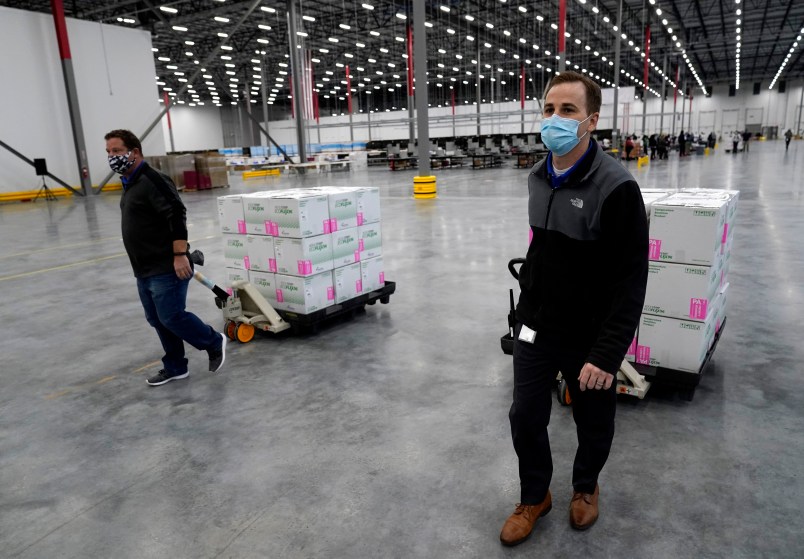It’s official: the Trump administration will deliver 14 million doses of COVID-19 vaccine to the states by the end of the year.
That’s at least six million fewer doses than what officials had promised, meaning that Operation Warp Speed will miss its first distribution goal.
“That number is lower than what we hoped for,” Operation Warp Speed CEO Moncef Slaoui told reporters on a Wednesday call with the effort’s chief operating officer, Gen. Gustave Perna.
The number of doses that have been injected into people’s arms remains unclear due to reporting delays, the official said, though the CDC’s current estimate it 2.1 million.
On the call, Perna and Slaoui both backed off Operation Warp Speed’s previous estimate that 20 million Americans would be vaccinated by the end of December. Rather, they’re claiming that, after a shipment scheduled to be allocated tomorrow, 20 million doses will have been shipped by the first week of January.
The explanation elides a key difference between Trump administration’s officials earlier statements: that 20 million would be vaccinated by the end of the month.
HHS Secretary Alex Azar said in November that the Trump administration would distribute 40 million doses for 20 million full-course vaccinations in the month of December; Operation Warp Speed officials have said that an additional 20 million doses are waiting in storage for the second dose.
But Perna confirmed on Wednesday that, as of this month, only 14 million doses will have been distributed to the states, with far fewer actually injected. That’s a stark difference from what top Trump administration officials were claiming only weeks ago, and highlights the extent to which predictable problems in state-level distribution have hampered the effort to get out the vaccine.
Now that the distribution effort has run into difficulties, officials from the President on down have taken to blaming state and local officials who are responsible for getting the shots into people’s arms, and who have received a minimal amount of funding to orchestrate the effort.
Adm. Brett Giroir, Assistant Secretary for Health, told MSNBC on Tuesday that it’s a state and local responsibility “to get vaccines in arms like it always is, every year — 170 million flu shots — that’s done at the local level.”
“The federal government doesn’t invade Texas or Montana and provide shots to people,” he added.
In the case of the COVID-19 vaccine, the federal government only began to provide significant funding for the effort this week, after Congress passed $8 billion to help state and local health departments administer the shot.
Experts said that the distribution issues will likely lengthen the timeline by which the vaccines will be widely available.
In response to a question of whether the problems would extend widespread availability of vaccines past the April timeframe that some officials have said is reasonable, Slaoui replied by saying that the country would have a large quantity of vaccine doses available by that time.
“Our plans continue to be the same,” Slaoui said, without addressing the distribution side of the question.
He added separately that Operation Warp Speed was open to any and all feedback.
“We would like to invite anybody that has the energy to participate and improve the administration of the vaccine to come to the table, put your sleeves up, and come to us with specific idea,” he said, adding that “any input needs to be specific and actionable.”







Yeah, who the hell is dumb enough to believe even this figure on Dec 30?
Q: Who could have seen this coming?
A: Anyone who knows anything about logistics.
I don’t understand how it’s possible to be this incompetent on purpose, to fuck things up this badly has to be deliberate? Even malign indifference can’t explain it.
Yikes. I used to (initially) respect this guy.
Wah wah waaaaahhhhhh! (Sad but predictable trombone.)
It just smells like the usual overpromising and underdelivering that comes when politicians jump ahead of reality and make rosy promises.
All the underlings try to please them and present similarly rosy projections, while the actual folks working the actual plans present the real numbers, only to have those rejected from being pushed up and out, because the top guy promised something bigger, and the folks working directly for him don’t want to get yelled at.